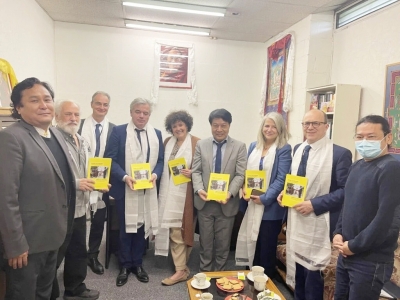
Dharamsala, May 3: In a unique show of solidarity for the non-violent struggle, 76 European towns have formally adopted Tibetan towns and villages, scattered across the Himalayas and the Tibetan plateau, as sister cities to demonstrate their support in preserving unique culture and heritage facing threat at the hands of Chinese policies in Tibet.
A book, “Thank You Europe For Adopting Tibetan Communes in solidarity with Tibet”, funded by Aide a l’Enfance Tibetaine, was released by French Senate Tibet Support Group President Jacqueline Eustache-Brinio at a function in Taste of Tibet Restaurant, an excellent outlet for authentic Tibetan and Indian food, in Paris on Monday.
Besides Eustache-Brinio, a delegation from Tibet Support Group in France senate comprising JoAalle Garriaud-Maylam, Andre Gattolin, Alain Houpert and the group secretary Thierry Munier visited the Tibet Office to show their support and solidarity for Tibet.
Tibet Office Paris representative Tashi Phuntsok thanked the senators for their continuous support for the Tibetan cause and updated about His Holiness the Dalai Lama’s health and programmes.
The main objective of the town adopting campaign was to preserve the identity of the communes within their own territory as was done for the Romanian communes to broaden the French communes horizon towards other cultures, other people of the world and to act as French citizens, guarantor of a motto which speaks of liberty, equality and fraternity, says Dharamsala-headquartered Central Tibetan Administration (CTA).
It blames China’s education policy in Tibet that not only threatened linguistic and cultural identity of the Tibetan people, but aggravated the assimilation of minority Tibetan people into the majority Han Chinese.
According to the CTA, the city of Montbeliard in eastern Franche Comte and the municipality of Amfreville la Mivoie became the latest Municipalities in France on October 6, 2012, to adopt Tibetan villages. While Montbeliard formally adopted Kharta, a small Tibetan village at the foothills of Mount Everest, Amfreville la Mivoie adopted Phari in western Tibet.
The six French cities and towns that have adopted Tibetan places are Lavelanet-de-Comminges adopted Narthang; Gensac-sur-Garonne adopted Gadong; Bax adopted Rong; Carbonne adopted Nagartse; Latrape adopted Riwoche and Mailholas adopted Dorjeling.
The Dalai Lama, the traditional spiritual leader of Tibet who fled to India in 1959, is the global face for a campaign that aims to preserve the religious, cultural, and linguistic identity of the Tibetan people.
He often speaks about the Tibetan culture and people who were originally a nomadic with a fairly simple way of life.
In his lectures, he describes how, when he reached India, he proposed setting up schools for Tibetan children that would teach Tibetan.
In due course, the monastic centres of learning were re-established too. These days several thousand monks and nuns have the opportunity to study rigorously. Young Tibetans who wish to join them must first master Tibetan which will equip them to study, become scholars themselves and so preserve the Tibetan tradition.
His Holiness points out that wherever Tibetans have settled efforts have been made to enable them to learn written and spoken Tibetan.
Similarly, across the Himalayan region initiatives have been taken not only for monastics, but for lay-people, young and old, to study and practise debate.
The Dalai Lama has been living in India since fleeing his homeland Tibet in 1959. The Tibetan administration is based in this northern hill town of Dharamsala in Himachal Pradesh.
This correspondent recently went to catch a glimpse of Tibet through Chinese eyes.
Over two-thirds the size of India, Tibet, also known as the ‘Roof of the World’ or ‘Third Pole of the Earth’, may no more be an enigma for the outside world now.
For, China has opened its door to the tourists after keeping the Tibet Autonomous Region in the southwest, the land rich in minerals and a variety of flora and fauna, out of bounds for ages.
The autonomous region pooled more than 500 million yuan (about $76.2 million) into tourism infrastructure projects to boost its tourism industry in 2021, the regional tourism development department said last week.
The area received over 41.5 million visitors in 2021, increasing 18.5 per cent compared with figures in 2020. Tourism revenue generated during the period totaled 44.2 billion yuan, rising 20.6 per cent.
But for the foreign journalists and government dignitaries it’s still off-limits, fearing backlash for seizing control of the Tibetan monasteries and expanding Chinese education rather than the local language.
The tastefully lit square with magnificent fountains facing the famed, majestic Potala Palace, once the seat of the Dalai Lama, is the most visited place, especially in the evening.
The entire Tibet region is populated mainly by tribals. The climatic conditions are harsh as much of the land is a cold desert where the mercury drops to below minus 20 degrees Celsius in winter.
















